问题背景
以缓存为例,在整个微服务系统中,缓存可以是多个节点
- 一是为了提高稳定,单节点宕机情况下,整个存储就面临服务不可用
- 二是数据容错,同样单节点数据物理损毁,而多节点情况下,节点有备份,除非互为备份的节点同时损毁
为了更好的访问各个节点,使用了Hash算法。把任意长度的输入通过散列算法变换成固定长度的输出,该输出就是散列值,对应不同的节点。如果直接使用取模的方式,如:
value=key%N
其中N为缓存节点(访问单元)的数目,当节点因为异常而退出的时候
- 如果未感知N的变化,那么单个节点所有
key都无效导致无法访问,容易引起缓存雪崩
- 如果感知到N的变化
N = N - 1,那么整个集群所有的 Key 都移位,更加容易引起缓存雪崩
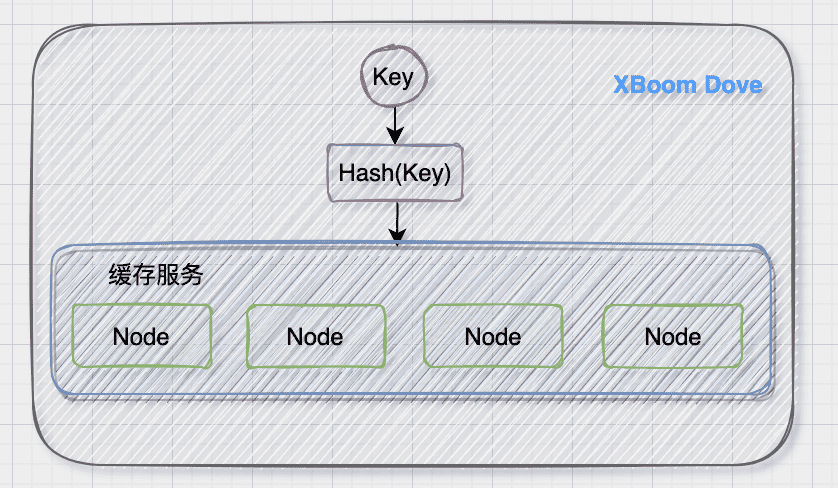
所以就引入了一致性Hash(Consistent Hash)
实现原理
基础类型
最基础的一致性 hash 算法就是把节点直接分布到环上,从而划分出值域, key 经过 hash(key) 之后,落到不同的值域,则由对应的节点处理(图中逆时针)
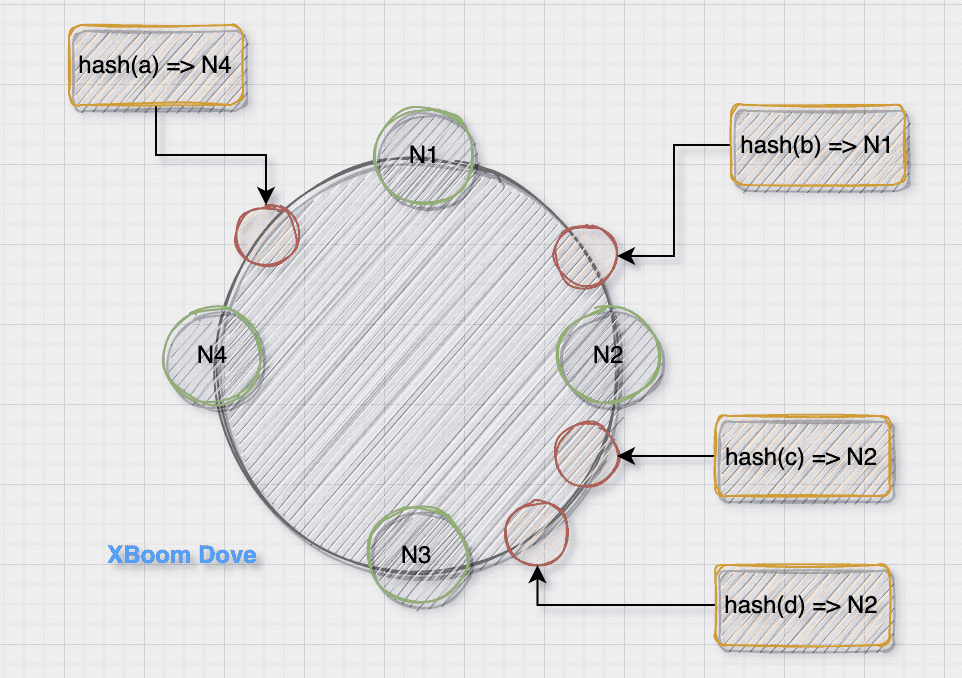
新增节点
当在N2节点与N3节点之间新增N5节点的时候,只有d的位置受到了影响,其他不变
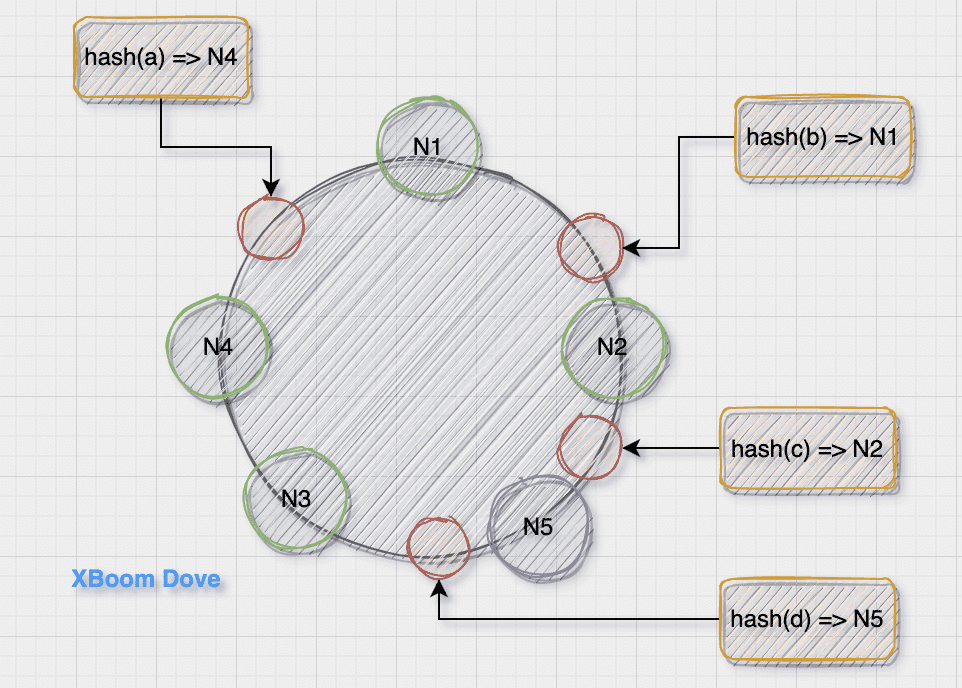
删除节点
当删除N2节点的时候,也只有c的位置收到的影响
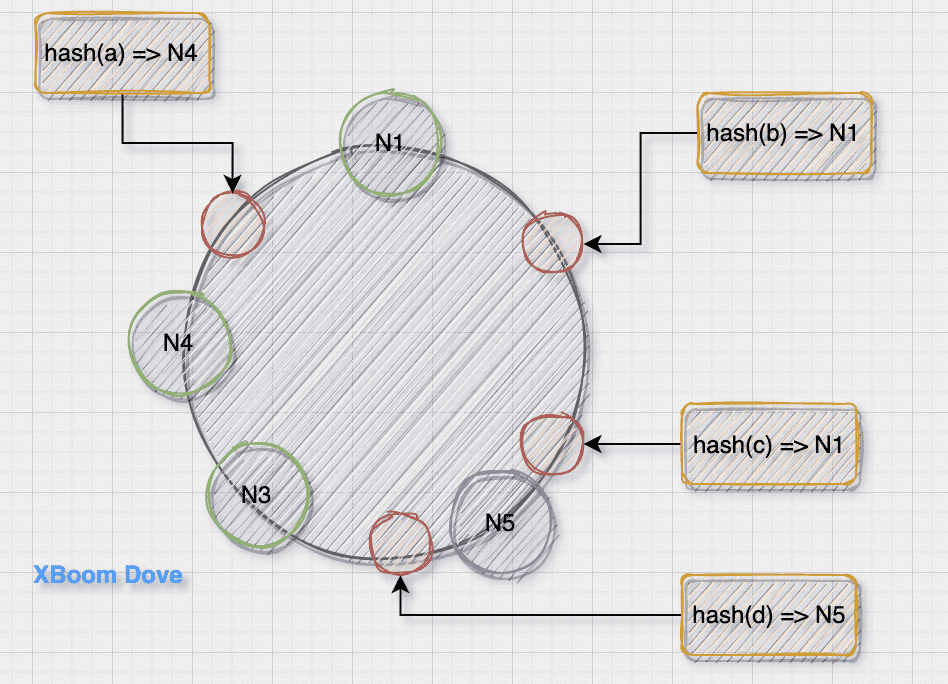
这样仍然存在问题:
-
随机分布节点的方式使得很难均匀的分布哈希值域(物理节点较少)
-
在动态增加节点后,即使原来是均匀分布后面也不再均匀分布;
-
增删节点带来的一个较为严重的缺点是:
虚拟节点
针对基础一致性 hash 的缺点一种改进算法是引入虚节点(virtual node)的概念。这个本质的改动:值域不再由物理节点划分,而是由固定的虚拟节点划分,这样值域的不均衡就不存在了。
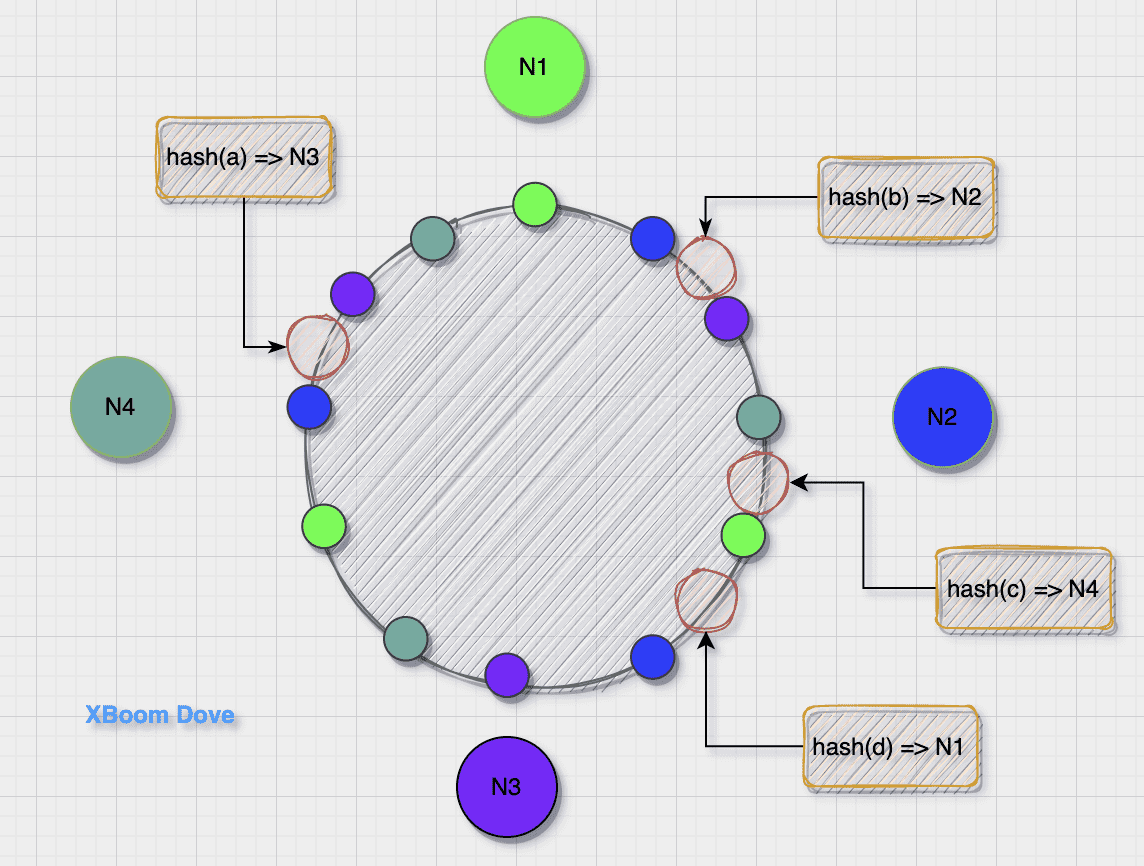
注意:
- 虚拟节点的个数要远大于物理节点的个数
- 虚拟节点的分布是交错的,如果只是虚拟节点增加而不交叉,会无法在删除/新增节点时分摊压力
- 每个物理节点对应的虚拟节点也是相等的,可以使节点平均分配
- 操作数据时,首先通过数据的哈希值在环上找到对应的虚节点,进而查找元数据找到对应的真实节点(旁白:所以这部分元数据是需要存下来的);
那么这个时候再来删除和新增节点的时候,就能很好的分摊压力了
- 增节点的时候要能为多个节点分摊压力
- 删节点的时候要能让多个节点承担压力
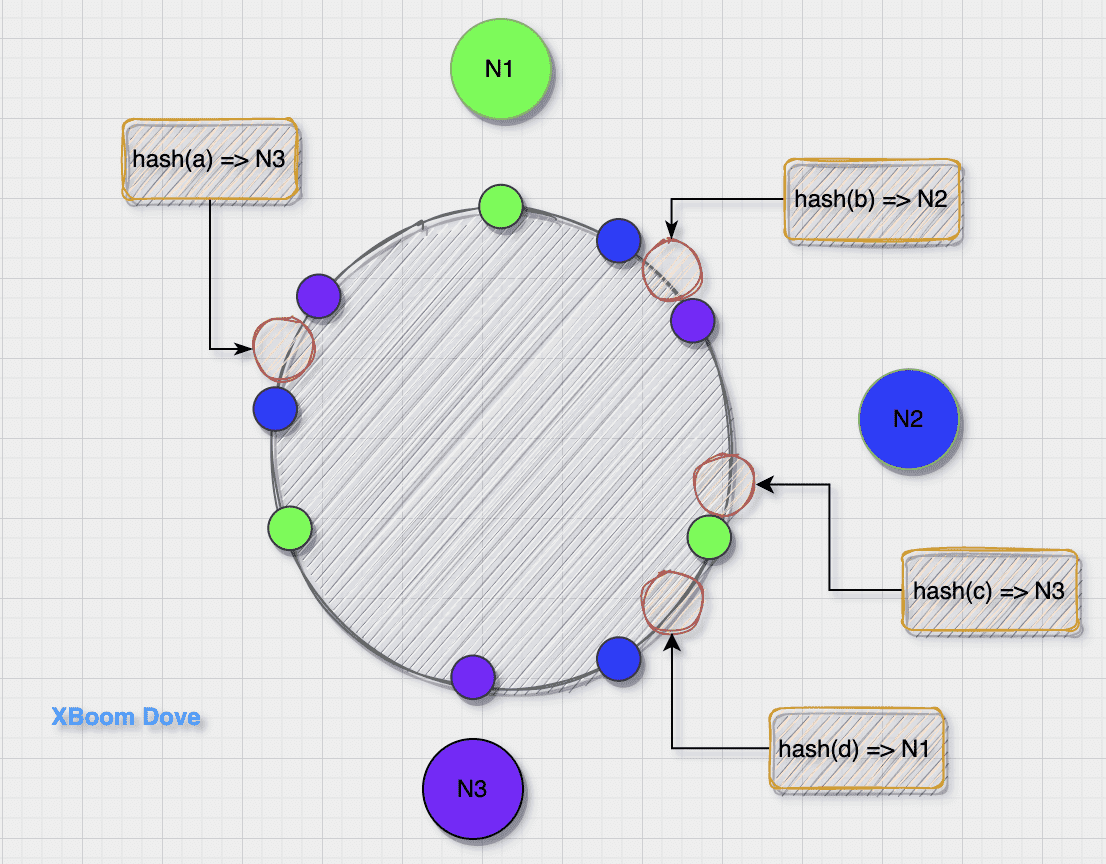
存在的问题
-
如何通过Key的Hash值找到对应范围所属的节点
认为Hash计算的值是随机的,符合概率分布。计算完所有节点的Hash之后需要进行一个排序
-
排序完怎么做到虚拟节点的交叉
通过计算每个虚拟节点的Hash值,然后整体进行排序
技术内幕
这里看看go-zero是如何实现一致性Hash的
对象定义
根据原理可知,实现一个一致性Hash需要知道
- 物理节点对应的虚拟节点的数目
- Hash函数
- 物理节点与虚拟节点的对应关系
- 环中虚拟节点的排序
1
2
3
4
5
6
7
8
9
10
11
12
13
14
15
16
17
18
19
20
21
22
23
24
25
26
27
28
29
30
31
32
33
| const (
TopWeight = 100
minReplicas = 100
prime = 16777619
)
type (
Func func(data []byte) uint64
ConsistentHash struct {
hashFunc Func
replicas int
keys []uint64
ring map[uint64][]interface{}
nodes map[string]lang.PlaceholderType
lock sync.RWMutex
}
)
func innerRepr(v interface{}) string {
return fmt.Sprintf("%d:%v", prime, v)
}
func repr(node interface{}) string {
return mapping.Repr(node)
}
|
新增节点
增加节点副本数
1
2
3
4
5
6
7
8
9
10
11
12
13
14
15
16
17
18
19
20
21
22
23
24
25
26
27
| func (h *ConsistentHash) AddWithReplicas(node interface{}, replicas int) {
h.Remove(node)
if replicas > h.replicas {
replicas = h.replicas
}
nodeRepr := repr(node)
h.lock.Lock()
defer h.lock.Unlock()
h.addNode(nodeRepr)
for i := 0; i < replicas; i++ {
hash := h.hashFunc([]byte(nodeRepr + strconv.Itoa(i)))
h.keys = append(h.keys, hash)
h.ring[hash] = append(h.ring[hash], node)
}
sort.Slice(h.keys, func(i, j int) bool {
return h.keys[i] < h.keys[j]
})
}
func (h *ConsistentHash) addNode(nodeRepr string) {
h.nodes[nodeRepr] = lang.Placeholder
}
|
注意:
h.ring[hash]这里使用的是切片,为了防止虚拟节点存在冲突,也就是一个虚拟节点可能对应多个物理节点。
设置权重节点
1
2
3
4
5
6
7
|
func (h *ConsistentHash) AddWithWeight(node interface{}, weight int) {
replicas := h.replicas * weight / TopWeight
h.AddWithReplicas(node, replicas)
}
|
删除节点
1
2
3
4
5
6
7
8
9
10
11
12
13
14
15
16
17
18
19
20
21
22
23
24
25
26
27
28
29
30
31
32
33
34
35
36
37
38
39
40
41
42
43
44
45
46
| func (h *ConsistentHash) Remove(node interface{}) {
nodeRepr := repr(node)
h.lock.Lock()
defer h.lock.Unlock()
if !h.containsNode(nodeRepr) {
return
}
for i := 0; i < h.replicas; i++ {
hash := h.hashFunc([]byte(nodeRepr + strconv.Itoa(i)))
index := sort.Search(len(h.keys), func(i int) bool {
return h.keys[i] >= hash
})
if index < len(h.keys) && h.keys[index] == hash {
h.keys = append(h.keys[:index], h.keys[index+1:]...)
}
h.removeRingNode(hash, nodeRepr)
}
h.removeNode(nodeRepr)
}
func (h *ConsistentHash) removeRingNode(hash uint64, nodeRepr string) {
if nodes, ok := h.ring[hash]; ok {
newNodes := nodes[:0]
for _, x := range nodes {
if repr(x) != nodeRepr {
newNodes = append(newNodes, x)
}
}
if len(newNodes) > 0 {
h.ring[hash] = newNodes
} else {
delete(h.ring, hash)
}
}
}
func (h *ConsistentHash) removeNode(nodeRepr string) {
delete(h.nodes, nodeRepr)
}
|
注意:
- 使用二分法进行节点查找
- 由于一个虚拟节点对应多个物理节点,不能直接删除虚拟节点
获取节点
根据v顺时针找到最近的虚拟节点,再通过虚拟节点映射找到真实节点
1
2
3
4
5
6
7
8
9
10
11
12
13
14
15
16
17
18
19
20
21
22
23
24
25
26
27
28
29
| func (h *ConsistentHash) Get(v interface{}) (interface{}, bool) {
h.lock.RLock()
defer h.lock.RUnlock()
if len(h.ring) == 0 {
return nil, false
}
hash := h.hashFunc([]byte(repr(v)))
index := sort.Search(len(h.keys), func(i int) bool {
return h.keys[i] >= hash
}) % len(h.keys)
nodes := h.ring[h.keys[index]]
switch len(nodes) {
case 0:
return nil, false
case 1:
return nodes[0], true
default:
innerIndex := h.hashFunc([]byte(innerRepr(v)))
pos := int(innerIndex % uint64(len(nodes)))
return nodes[pos], true
}
}
|
注意:
- 如果虚拟节点对应多个物理节点那么通过hash获取在节点中的位置
总结
- 通过增加虚拟节点的数目来使的hash的分布更加均匀
- 虚拟节点的应该是交叉的(实现中并不是严格交叉,而是通过Hash再排序让虚拟节点交叉存在)
参考链接
- 分布式系统基石一
- 搞懂一致性Hash
- https://talkgo.org/t/topic/3098





